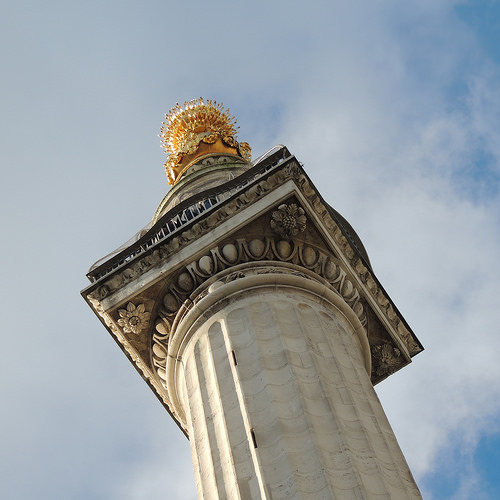The Monument
Many people walk past this remarkable stone column every day without paying any attention to why it was built or what it represents. The column stands at the corner of Fish Street Hill and Monument Street in the heart of the City of London. It was constructed some time between 1671 and 1677 in commemoration of one of the most major and most dramatic incidents that the city has ever witnessed, the Great Fire of London. It was built to not only commemorate the massive destruction, but also the grand rebuilding project that was undertaken by the city.

Most people know that the fire originated in a bakers shop on Pudding Lane on a quiet Sunday in the September of 1666. The fire raged for several days before it was finally extinguished on September 5th leaving huge swathes of the city reduced to ashes. Remarkably there was very little loss of life considering the size of the disaster, though thousands of buildings were completely destroyed. It was only the buildings that were of stone construction that managed to survive, such as the Guildhall and St Paul’s.
A Permanent Memorial
The decision to erect a permanent monument to the fire was made at the same time that they started to rebuild the city, its site was decided based on its location to the source of the blaze that razed the city. The design was provided by Sit Christopher Wren and Dr Robert Hooke. Inside the Doric stone column are 311 stone steps which lead to a lofty viewing platform. The top of the column is decorated with a large drum and urn from which stylised flames emerge in memory of the Great Fire. It is simply referred to as ‘The Monument’, a name as fitting as any it could have been given. It stands an impressive 202ft high (61 metres) which coincidently is the exact distance between where it is located and the site of the original bakers shop on Pudding Lane where the fire originated in 1666. The Monument was designed especially for use by colleagues of the Royal Society for the performing of experiments, however as road traffic increased so did the vibrations up the column and the experiments were discontinued. It remains a site of special historical interest though and provides a unique perspective of the city from atop the viewing platform.
Incidents and Accidents
The Monument has been the site of a number of noteworthy incidents. During the mid 1700’s there was a cage suspended from the viewing balcony in which there was kept an eagle. It was while leaning over the balcony to view the bird that weaver William Greer fell to his death in the June of 1750. It has also been the site of several suicides as between 1788 and 1842 a total of six people jumped to their deaths from the public viewing gallery, it was as a result of these deaths that an iron cage was built around the gallery to prevent any more either wilful or accidental deaths.

